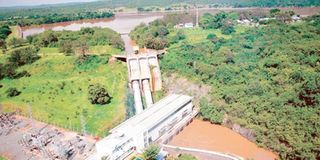Kindaruma to inject additional 72MW into the power grid

The Kindaruma hydro power station in Embu county.
What you need to know:
- Energy and Petroleum Cabinet Secretary, Mr Davis Chirchir however said his ministry is studying the different components of the electricity bill as well as the distribution infrastructure so as to establish the true cost of power.
A programme to grow the country’s power supply has received a huge boost following the completion of an upgrading programme at the Kindaruma power plant.
Kindaruma, which was commissioned in 1968, was originally designed to house three turbine generator units. However, only two turbines with a capacity of 20 megawatts (MW) each were installed at the time due to low energy needs.
But with rising demands for electricity, the output of the two units was targeted for optimisation and a new 24MW turbine installed early in the year.
“This has been followed by upgrading the existing old units from 20MW to 24MW. With all the three units now generating 24MW each, the total output has jumped from 40MW to 72MW,” said the Kenya Electricity Generating Compnay Manager in Charge of Eastern Hydros, Francis Kawa.
Mr Kawa was speaking to the Nation at Reverend Muhoro Secondary for the Deaf in Mukurweini after KenGen donated Sh200,000 towards a project to buy a school bus for the institution.
He also noted that last year, KenGen had installed a solar energy lighting system in the school at a cost of Sh1 million to help cut down the cost of electricity bills.
KenGen Senior Communication Officer Kaara Wainaina, however, clarified that the Kindaruma project was still in the contractors’ hands and they were running reliability tests before commissioning could take place.
The project contractors were Andritz Hydro from Austria, who handled the electrical and mechanical works, while the civil works were undertaken by Farab Company. The project has taken 33 months to complete.
According to Mr Kawa, Kindaruma’s rehabilitation will cost Sh5.4 billion which has been financed by KfW and KenGen. KfW Banking Group is a German government-owned development bank based in Frankfurt.
Demand for power
Mr Kawa said KenGen has launched an aggressive strategy to grow power supply in the country ahead of annual demand that is growing at an estimated eight per cent per annum.
Among other projects underway by the company is the Sh84 billion Olkaria 280MW project which is the largest power plant build undertaken in the country’s history.
Once complete, the project will raise KenGens total output by 25 per cent. The power utility is also in the process of upgrading the power output at its Ngong wind plant five-fold, from its current 5.1MW capacity to 25.5MW.
The Kindaruma project has been completed at a time the country’s sole power distributor—Kenya Power (KP)—is battling to increase power tariffs. In last February, KP approached the Energy Regulatory Commission (ERC) with a request to increase charges, which have remained unchanged since 2004.
The firm is also fighting to increase the cost of connecting new customers to the grid to Sh70,000 from the current Sh34,980.
Energy and Petroleum Cabinet Secretary, Mr Davis Chirchir however said his ministry is studying the different components of the electricity bill as well as the distribution infrastructure so as to establish the true cost of power.
The minister said a new pricing structure would seek to give KP a fair profit margin while at the same time cushion consumers from paying punitive costs, some of which may have been incurred due to inefficiencies within the power distributor company’s systems.
Earlier, Deputy President William Ruto issued a directive that the company should not increase tariffs, but should instead look for means to lower its costs of operation and find alternative sources of financing its infrastructure projects.




